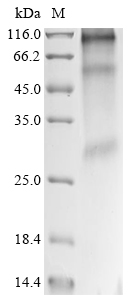The Recombinant Human CD63 antigen comes from an E.coli-based cell-free expression system, which appears to produce the full-length mature protein quite efficiently—covering amino acids 2 to 238. The protein includes an N-terminal 10xHis-tag that makes purification and detection more straightforward. SDS-PAGE analysis suggests the product achieves purity levels above 90%. By using a detergent platform, the recombinant CD63 seems to keep its structural integrity intact, including all four transmembrane domains, which likely contributes to consistent performance in research settings.
CD63 belongs to the tetraspanin family and plays what appears to be an important role in cellular processes like adhesion, migration, and signal transduction. The protein helps form microdomains within cell membranes, which may influence different signaling pathways. Many researchers focus on CD63 when studying exosome biogenesis and cell communication, particularly in immunology and cancer biology work.
Potential Applications
Note: The applications listed below are based on what we know about this protein's biological functions, published research, and experience from experts in the field. However, we haven't fully tested all of these applications ourselves yet. We'd recommend running some preliminary tests first to make sure they work for your specific research goals.
Based on the provided information, the recombinant Human CD63 antigen is expressed using an in vitro E. coli expression system (cell-free system), which can enhance proper folding of complex proteins by reducing cellular stress and aggregation. CD63 is a tetraspanin membrane protein with 4 transmembrane domains, making its correct folding challenging even in optimized systems. The protein is expressed as the full-length mature form (2-238aa) with an N-terminal 10xHis tag, and purity exceeds 90%. However, since activity is unverified, the protein cannot be assumed to be correctly folded or bioactive. While the cell-free system improves folding probability, the complex transmembrane structure of CD63 requires validation through functional assays (e.g., tetraspanin web formation or antibody binding to conformational epitopes) to confirm native conformation.
1. Membrane Protein Reconstitution Studies
The detergent-solubilized CD63 can be used for membrane reconstitution into liposomes, but if misfolded, its transmembrane domain organization and orientation may not reflect native behavior, leading to non-physiological results. The His-tag aids tracking, but proper folding must be confirmed first (e.g., via protease accessibility assays) to ensure reconstitution studies are biologically relevant. If correctly folded, this application is valuable; otherwise, data may be misleading for understanding native CD63 function.
2. Antibody Development and Epitope Mapping
This application is well-supported. The full-length CD63 can serve as an immunogen for generating antibodies, as it contains both linear and potential conformational epitopes. However, if misfolded, antibodies may not recognize native CD63 in cellular contexts (e.g., exosomes or lysosomes). The His-tag facilitates purification for immunization, but antibodies should be validated against native CD63 from human cell lines to ensure specificity for physiological studies.
3. Protein-Protein Interaction Screening
The His-tag enables pull-down assays, but if CD63 is misfolded, interactions identified may be non-physiological. Tetraspanins like CD63 require correct conformation to associate with partners in the "tetraspanin web" (e.g., integrins or other tetraspanins). The detergent-solubilized format may not fully replicate the membrane environment, increasing the risk of false positives/negatives. This application should be pursued only after validating folding (e.g., via conformational antibodies).
4. Biochemical Characterization and Stability Studies
This application is appropriate and should be prioritized. Techniques like dynamic light scattering, thermal stability assays, and detergent compatibility testing can directly assess the protein’s folding state, oligomerization, and stability. These studies are valuable even if the protein is inactive, as they provide critical data on the recombinant product’s properties and ideal handling conditions. The cell-free system’s consistency supports reproducibility.
Final Recommendation & Action Plan
Given the uncertainty in folding, recommend first performing biochemical characterization (e.g., size-exclusion chromatography to check oligomeric state, circular dichroism for secondary structure) and functional validation (e.g., binding to known anti-CD63 antibodies that recognize conformational epitopes). If the protein is properly folded, it can be used for interaction studies and reconstitution experiments; if not, focus on antibody development and biochemical analyses. For all applications, include controls such as native CD63 from mammalian cells to ensure biological relevance. The cell-free expression system is advantageous for reducing aggregation, but verification remains essential for this complex membrane protein.




